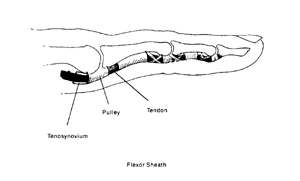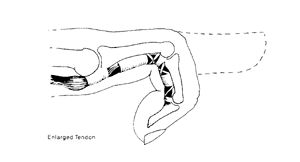Home | Education | Tendon Disorders | Trigger Finger

Diagram 1:Normal anatomy flexor sheath showing pulley, tendon, and tenosynovium.

Diagram 2: Abnormal anatomy showing enlarged tendon catching on flexor sheath.
Dr. Smith provides a comprehensive multidisciplinary approach for the evaluation, treatment and care of trigger finger and trigger thumb.
The information on this webpage is based on material from the American Society for Surgery of the Hand and is for educational purposes only.

Trigger Finger or Trigger Thumb
By Houston Hand Surgery Specialist & Orthopaedic Surgeon, Dr. Dean Smith
Trigger finger or trigger thumb, medically known as stenosing tenosynovitis, involves the pulleys and tendons in the hand that bend the fingers (see Diagram). The tendons work like long ropes connecting the muscles of the forearm with the bones of the fingers and thumb. In the finger, the pulleys form a tunnel under which the tendons must glide. These pulleys hold the tendons close against the bone. The tendons and the tunnel have a slick lining that allows easy gliding inside the pulleys (see Diagram 1).Diagram 1:Normal anatomy flexor sheath showing pulley, tendon, and tenosynovium.

What is Trigger Finger/Thumb?
Trigger finger/thumb happens when the tendon develops a nodule (knot) or swelling of its lining. When the tendon swells, it must squeeze through the opening of the tunnel (flexor sheath) which causes pain, popping, or a catching feeling in the finger or thumb (see Diagram 2). When the tendon catches, it produces inflammation and more swelling. This causes a vicious cycle of triggering, inflammation, and swelling. Sometimes the finger becomes stuck (locked) and is hard to straighten or bend.Diagram 2: Abnormal anatomy showing enlarged tendon catching on flexor sheath.
Causes of Trigger Finger/Thumb
Causes for this condition are not always clear. The medical conditions of rheumatoid arthritis, gout, and diabetes may be associated with trigger finger/thumb symptoms.Signs and Symptoms of Trigger Finger/Thumb
Trigger finger/thumb may start with discomfort felt at the base of the finger or thumb. A thickening may be found in this area. When the finger begins to trigger or lock, the patient may think the problem is at the middle knuckle of the finger or the tip knuckle of the thumb.Treatment for Trigger Finger/Thumb
The goal of treatment in trigger finger/thumb is to eliminate the catching or locking and allow full movement of the finger or thumb without discomfort. Swelling around the flexor tendon and tendon sheath must be reduced to allow smooth gliding of the tendon. The wearing of a splint or taking anti-inflammatory medication by mouth or an injection into the area around the tendon may be recommended to reduce swelling. Treatment may also include changing activities to reduce swelling.Surgical Treatment of Trigger Finger/Thumb
If non-surgical forms of treatment do not improve symptoms, surgery may be recommended. This surgery is performed as an outpatient. The goal of surgery is to open the first pulley so the tendon will glide more freely. Active motion of the finger generally begins immediately after surgery. Normal use of the hand can usually be resumed once comfort permits. Some patients may feel tenderness, discomfort, and swelling about the area of their surgery longer than others. Occasionally, hand therapy is required after surgery to regain better use.Dr. Smith provides a comprehensive multidisciplinary approach for the evaluation, treatment and care of trigger finger and trigger thumb.